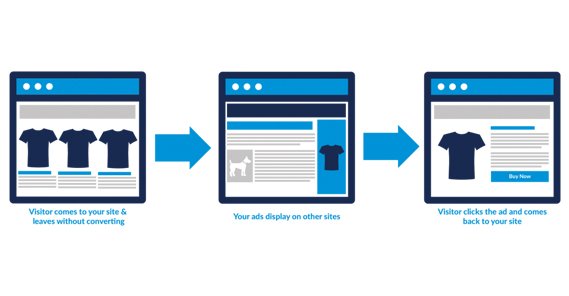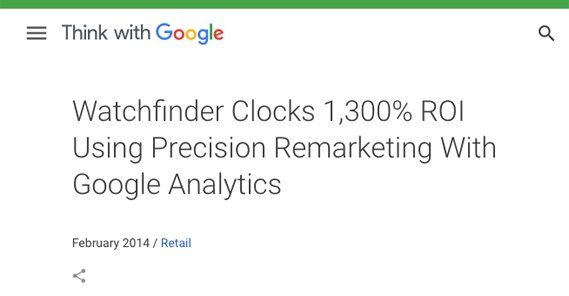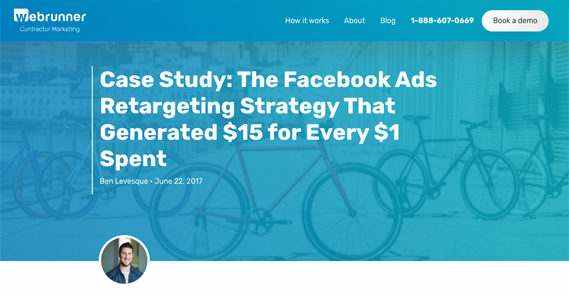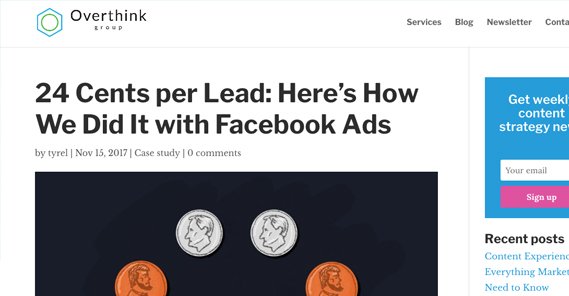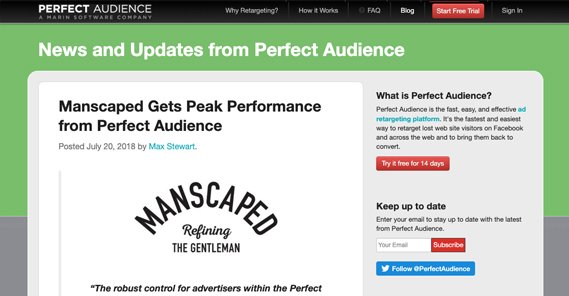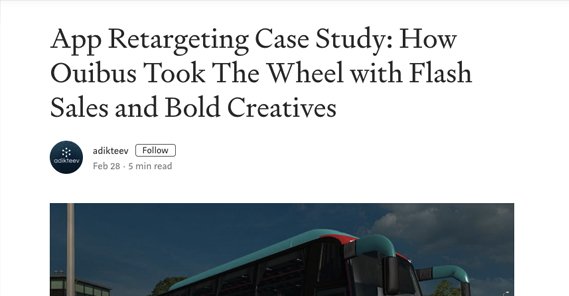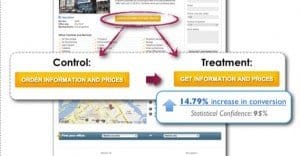5 Case Studies of Successful Retargeting Ad Campaigns
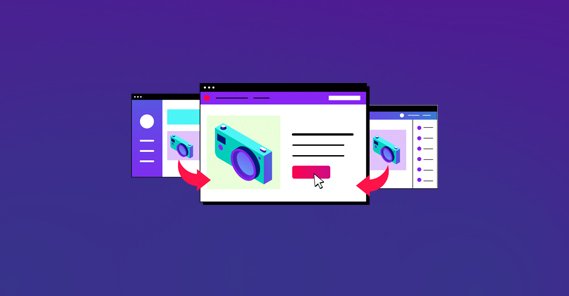
If you’ve looked into PPC advertising any time over the past few years, you’ve probably seen mention of retargeting or remarketing, especially with Facebook and Google ads. You’ll see fantastic headlines like “250% increase in ROI!” and “More than double your conversion rate!” and other pie-in-the-sky promises. But are those promises really just dreams, or is this kind of benefit achievable from retargeting?
All About Retargeting and Remarketing
Retargeting and remarketing are very similar terms, and I have to admit I’m guilty of using them basically interchangeably. I’m not alone, either; even Google uses them interchangeably in their discussions in their ads system.
If you’re going to be a pedant or if you care about historic, specific definitions, there’s a difference between retargeting and remarketing. Retargeting is focused on display advertising; reaching people through PPC advertising when those people have already taken some form of engagement with your brand. Meanwhile, remarketing is focused on email; reaching people via email when those people have engaged with your brand in some way. Remarketing involves messages like Amazon constantly sending you emails about products you clicked on but didn’t buy, or any web store that sends you a message about “items are still in your cart.”
Both types of “Re:”-ing operate in a similar way using similar concepts. The “Re”, after all, means to repeat something. You are building a list of people who have engaged with your brand in some way, typically by clicking existing broad-target advertising, visiting your website through social channels, or otherwise visiting one of your properties. You are then using that list to market directly to those users, a repetition of marketing.
Since those users have already visited your site, they have expressed interest in your brand. They are, by definition, already a more engaged audience than people who ignore your ads and don’t visit your site. This makes them a better target for future advertising.
Now, of course, some of those people saw your site and decided there’s some factor that prevents them from buying. Maybe they don’t like your brand, maybe the price is too high, maybe you don’t offer what they hoped you did. That’s why a retargeting audience will never have a 100% conversion rate. Some people – we marketers in particular – also tend to click ads just to study landing pages with no intention of ever making a purchase.
Others, though, will be more than willing to make a purchase. Many people who click ads are doing so because they’re interested, but are not in a position to buy. Maybe they need approval from a manager to make a purchase. Maybe they need to talk with their family. Maybe they need to wait until the next payday, or just check their budget. Maybe they just don’t want to make a purchase via their mobile device and would rather wait until they’re on a home computer. You never know. Through retargeting, you can remind those people of the purchase they were planning to make, and can catch them at a time they’re more likely to buy.
Retargeting is often thought of in the context of Facebook ads and Google ads, but I’ve included case studies that showcase retargeting in other contexts as well. Instead of just targeting people through Facebook and Google search results, some companies have found retargeting success with ads in apps and ads through other advertising networks. There are plenty of other case studies out there as well; I’ve tried to choose a diverse selection rather than a broadly representative selection.
If you want to read a bunch more case studies beyond the ones I’ve highlighted below, you have a lot of options. Here are a few other directories you can read:
- ConversionXL’s List of 7 Retargeting Case Studies
- KlientBoost’s Guide to 35 Different Retargeting Strategies with Case Studies for Each
- Bannerflow’s List of 11 Retargeting Ideas
- Our List of 15 Examples of Effective Retargeting
The concept is sound, the core idea is solid. The question is, does it really work in practice? Everyone who writes about marketing says it does, but of course most of us are selling something. So instead of just assuring you it works, I’ve compiled a handful of case studies you can use to judge for yourself.
Case Study #1: Watchfinder
This case study focuses on the brand Watchfinder, which sells luxury pre-owned watches. Given their narrow audience and specific situation for purchasing, they discovered that fewer than 1% of their visitors made a purchase on their first visit. This is a great situation for retargeting to reach and remind those customers to step in and make a purchase on that watch they’ve been eyeballing.
This case study focuses on Google Ads, using Google Analytics to gather data about their visitors to produce retargeting lists. They used this data to create 20 distinct lists of customers, based on their location, language, depth in the sales funnel, ISP, and other factors. Each of these 20 lists made up a distinct group of users in a specific situation. Watchfinder (and their agency Periscopix) was able to create specific targeted ads focusing on these lists based on their context. In addition to driving return visits to their website, they emphasizes stopping into the company’s then-new boutique outlet in London, for those geographically local.
So what were the results? After six months of running these remarketing campaigns, with optimizations along the way, Watchfinder calculated a few benefits. The average order size on the site was 13% higher. CPAs were 34% lower. Return on investment was 1,300%.
This case study is from 2014, though, so you have to wonder; are these kinds of results still possible?
Case Study #2: Myfix Cycles
Myfix Cycles is a bicycle retailer located in Toronto. They had been using Google AdWords to little effect, barely breaking even with the ads they were running. Rather than focus on purely Google retargeting, they decided to combine their efforts – via their agency, Webrunner Media Group – with Facebook advertising. This case study is from 2017.
Facebook allows any company to install a tracking code called the Facebook Pixel on their website. This tracks visits and user data about the people who visit, even if those people have never seen the Facebook account for the business. Google ads brought people to their website, where the Facebook Pixel would track them. They could then run Facebook ads targeting users with specific criteria.
Myfix chose three groups of people to target with these retargeting advertisements. The first group was people who had recently visited the website at all, within the previous 14 days. The second group was a subset of that group, people who had added a product to their cart within the past 14 days. The third group was a slightly different audience, people who had made any purchase from Myfix within the previous 180 days.
The results? Myfix earned somewhere in the neighborhood of $15 for every $1 spent on these ads. That’s one hell of an increase over barely breaking even with ad spend, eh? Of course, the numbers are relatively small; only $3,000 in revenue from a shop that sells products averaging $300 in price, so it’s a relatively small case study. Still, you can’t argue with those kinds of numbers even at a small budget level.
Case Study #3: Jesus Film Project
This is another 2017 case study, this one from the Overthink Group on behalf of the Jesus Film Project. JFP is a Christian discipleship group looking to expand their email mailing list. While the mention of email might make you think this is remarketing rather than retargeting, this is actually using Facebook Ads in order to perform the retargeting to grow email.
This is a bit of an interesting case study, because it admits that while retargeting is a powerful strategy, it’s not guaranteed to be the best strategy among many. For these Facebook ads, Overthink created five different custom audiences on Facebook. Among these, only one was retargeted. They were:
- A lookalike audience based on the existing mailing list.
- An audience of people who engaged with the page.
- An interest-based audience.
- The audience of “people who already like the page.”
- A retargeting audience.
Among these, all of them received leads, as these were lead generation ads rather than ads with a purchase as the goal. The interesting part is that, while the retargeting list did successfully pull in new leads, those were the most expensive leads from the five audiences. Six cents per lead more than the second most expensive, and 22 cents per lead more than the cheapest. Overall, they pulled in 12,000 more email subscribers as of the time of the case study, though their ads were still ongoing then.
Case Study #4: Manscaped
“Manscaping” is a term used to promote male grooming, and Manscaped is a company producing specially designed and gendered grooming products with a whole list of buzzwords to promote them, like Active pH control. I’m not here to judge the product, though, just the results. This case study was performed by the agency Perfect Audience in 2018.
In this case, rather than experimenting with retargeting to see what happens, Manscaped was looking to maintain very specific Return on Ad Spend goals. Their retargeting focused on both website and mobile in-app advertising. In the past, they had troubles reaching their ROAS goals with mobile apps, so they turned to Perfect Audience.
Perfect Audience employed a customized lookback window, specific targeting for different mobile operating systems, and negative factors for audience exclusions. Additionally, they used dayparting to focus on the most effective parts of the day.
Overall, this allowed them to achieve their ROAS goal of 3.5x return on investment. As they succeeded, they were able to allocate more and more money to their ads budget and maintain their goals, achieving 137% growth month over month.
Case Study #5: Ouibus
This case study published on Medium by the agency Adikteev focuses on the company Ouibus. Ouibus is one of the largest bus service providers in Europe, with a large audience centering around France but covering all of Europe. They also maintain a travel app, which faces many challenges in the global travel industry as detailed in the article.
In this case, the company started out with a variety of static ads with a range of different creatives, mostly showcasing deals and event targeting. They included other ads with videos and rich media to make them more robust and allow them to target specific segments of their audience.
In a particularly interesting experiment, they played with scratch card advertising, which is inherently engaging to the people who are most interested in the service already. From there, they used retargeting audiences and flash sales to further maximize the engagement of the people they reached.
The case study primarily covers the benefits of their ad campaign in general, but it does highlight the specific benefits of retargeting over their purchases as a whole. Retargeting added on average about 10% more purchases month to month.
Your Experiences
I’m not the only one that can find case studies online, but what I’d like to do is hear from you. Many of you have used retargeting in your ad campaigns, and I’m curious how it turned out for you. Leave me your data in the comments if you’re willing to share, and maybe showcase your retargeting successes with the rest of the readers. Maybe your data can help convince someone to take the plunge with retargeting!
 ContentPowered.com
ContentPowered.com
